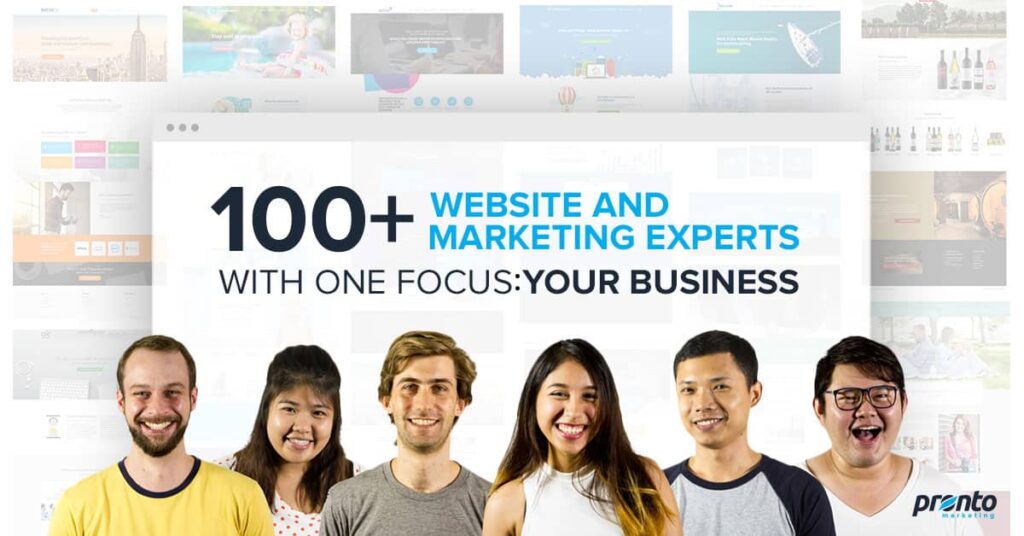No matter what you’re selling, you need words to seal the deal. For some business owners, that means proclamations of “I know words, I have the best words!” without any clear calls to action or paths to purchase.
But after having created thousands of websites for SMBs, we can assert quite confidently that it takes much more than that to craft web content that converts.
What it takes is an understanding of your average web searcher and their goldfish-like attention spans. Because without that, you’re probably going to end up prioritizing all your “best words” over the crux of what your readership really wants.
Pronto’s in-house editorial team focuses on three distinct types of web copywriting, but the #1 priority is always to keep content simple, and here are some of the ways they do it.
Home page content, banners, ads, etc.
As a general rule, you can assume that 80% of your readers will read just the headlines, headers and banner text, while a mere 20% reads what’s below them. So it’s important to pack these abbreviated spaces — which in the case of Google’s result titles are just 70 characters — with tons of information about your business, products, promotions, or whatever else you’re selling.
What a lot of writers end up doing instead is using this space to make clever jokes and use convoluted wordplay. Unless you’re selling self-help books for comedians, puns aren’t the answer to your audience’s problems.
For instance, the title for this article could’ve been 80/20 Content: Plagiarizing the Pareto principle for website production. Because everyone loves alliterations…right?
No. Writers and casual readers love alliterations. People searching for products on the web love finding what they’re looking for.
Even if Google did display that long-winded title for people’s “easy tips to improve website content” searches, no one is going to see it and think an article so titled would have easy answers to their questions.
Product/Service pages, about us content, etc.
Microsoft released a report in 2013 that claimed the average internet user’s attention span was eight seconds. By getting rid of overly clever headlines and banners, you leave readers with at least six or seven whole seconds for the rest of your content. What will they do with those precious moments?
Skim.
Love it or hate it, you must reformat content to catch wandering eyes. For example, this article includes:
- Numbers and symbols (can you remember all three? Skimmers probably can…)
- Single sentence paragraphs
- Sub headings that actually explain what they contain
- Bulleted lists (we even worked two into this article!)
Remember, your readers don’t care that you have “the best words,” or the fanciest metaphors. They care about getting the answers your titles, headlines, and banners promised them.
For content that seals the deal, make sure your answers are easy to find for everyone — including skimmers.
Blog articles, eBooks, Whitepapers, etc.
“Longform” content needs to incorporate all of the above, with a couple minor differences. First, because this content attracts readers who haven’t necessarily seen the rest of your site, you’ve got to provide background information they may have leapfrogged over.
If you’re a law firm that handles estate planning and you’re writing an eBook on power of attorney documents, you need to rehash some of the basics, or at least link to somewhere on your site that does. Otherwise, readers will quickly back out of your site feeling lost.
Second, longform content needs to take more than just search engine optimization (SEO) keywords into consideration. Keywords might help search engines recognize the topic of your content, but “carewords” are the layman’s terms that help readers find the information they’re looking for.
Someone looking for tips on optimizing headlines for search engines in this article might ctrl+F to search within the page for the word “results” and see the 70-character tidbit.
Compare this to if we had used “organic listings” instead. We might have ranked higher for searches from marketing insiders, and it would’ve showcased our impressive industry jargon, but at the cost of losing readers in our target audience.
This article isn’t short, but it is simple
A lot of web copy is longer than it needs to be, but don’t assume shorter is always better. Try focusing on what we discussed instead:
- Informative, straightforward headlines, titles, etc.
- Skimmable paragraphs, sentences, and bullet-point lists
- Concise summaries of background information for newcomers
- Eliminating industry jargon
Simple content that is easy to search, scan, and study is always better than complicated fluff that only you and your colleagues appreciate.
Need Some Help?

If you don’t have the time to master the art of web copy, our flexible price plans, all-in-one website service comes with all the copywriting and content creation tips your website could ever need. From stylized blogs to eCommerce copywriting, we can do it all. See for yourself.


